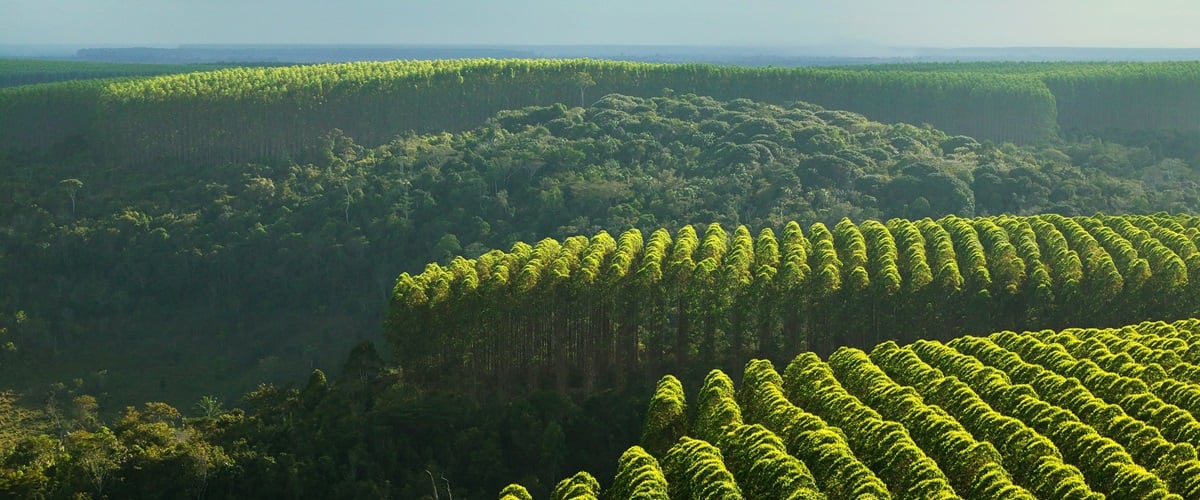
Tree plantations in South America
consist of a mosaic of areas for wood production and biodiversity management
Stora Enso’s joint operations in South America own and lease lands for plantation operations. Plantations typically consist of a mosaic of areas for intensive wood production and biodiversity conservation. Similar to our managed semi-natural Northern forests, plantations are also certified to ensure the consideration of environmental, social, and economic responsibility.
Stora Enso never establishes plantations in natural forests, protected areas, or water-sensitive locations, and only uses land with low biodiversity values, such as former pastureland. We recognise that our plantations are an integral part of local land use, and therefore evaluate and define sustainable land use practices specifically for each location.
Plantations in Brazil
-
In Brazil, Stora Enso has a 50% joint operation called Veracel with Suzano.
-
Veracel owns 209,000 ha of plantations and lands, of which 82,000 ha is used for pulp production. An area of 188,000 ha is CERFLOR (PEFC) and FSC certified.
-
Protected areas total to 105,000 ha, including a 6,000 ha Private Natural Heritage Reserve, and mostly consist of native forest remnants at different stages of regeneration.
-
Veracel also leases 23,000 ha of land, of which 9,000 is used for planting. Part of the leased lands is certified with CERFLOR (PEFC) (14,000 ha) and with FSC (14,000 ha).
Plantations in Uruguay
-
The plantations and lands in Uruguay are owned by Montes del Plata, which is our 50%-owned joint operation with Arauco.
-
The whole area of 190,000 hectares (ha) is certified with PEFC and FSC certification. 110,000 ha of land is used for pulp production.
-
Protected areas total to 77,000 ha and consist of remnants of native ecosystems, such as grasslands and riparian forests.
-
Montes del Plata also leases 86,000 ha of land, of which 74,000 ha is used for planting. Majority of the leased lands is PEFC and FSC certified (80,000 ha).
Plantation cycle and management
Our plantations are designed and managed in local land-use context, taking into account local livelihoods, land use, and conservation of native ecosystems. We establish plantations only on lands that have been used for agriculture in the past, and never convert natural forests into plantations.
Plantation management resembles agricultural production as plantations consist of only one species, usually eucalyptus. In plantations, the rotation cycle is much shorter than in the North, lasting only 6 to 10 years. The cycle begins with an establishment phase, continuing to maintenance phase and ending with harvesting.
Plantations also host a diverse range of ecosystems, and we want to preserve and enhance this biodiversity. We ensure biodiversity in plantations in several ways. Read more on our biodiversity management.

Establishment
The establishment phase lasts up to one year, and maintaining a healthy plantation requires several actions. These include mechanical soil preparation, application of agrochemicals for weed control, and plant nutrition to create an optimal environment for plant growth. In addition, ant control using special baits protects the plantation from pests, contributing to a healthy plantation.
Improved clonal seedlings are planted manually or mechanically while fertilisation and irrigation are performed at planting to support growth.

Harvesting

Maintenance and monitoring
The maintenance and monitoring stage lasts between two to six years in Brazil and up to nine years in Uruguay. During this period, mechanical spreading of agrochemicals ensures weed control and proper forest nutrition. Continuous ant control is also maintained. Ongoing monitoring of fire, pests, and diseases helps protect the plantation from potential threats.
We only use agrochemicals approved by certifications and regularly monitor the impact of our operations on the surrounding environment.


